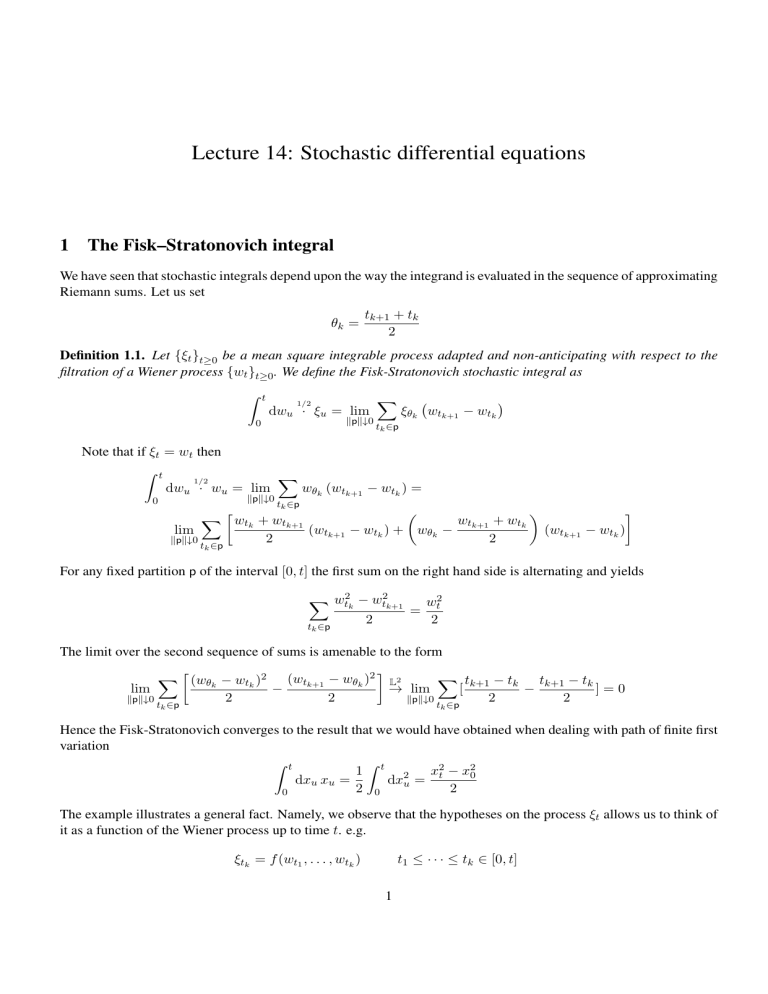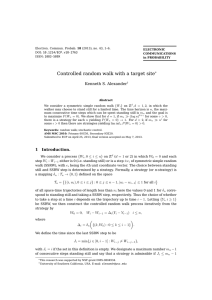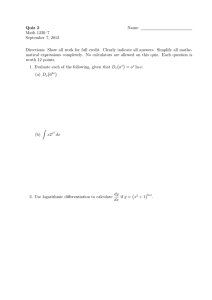Stochastic Differential Equations: Fisk-Stratonovich Integral
advertisement

Lecture 14: Stochastic differential equations
1
The Fisk–Stratonovich integral
We have seen that stochastic integrals depend upon the way the integrand is evaluated in the sequence of approximating
Riemann sums. Let us set
θk =
tk+1 + tk
2
Definition 1.1. Let {ξt }t≥0 be a mean square integrable process adapted and non-anticipating with respect to the
filtration of a Wiener process {wt }t≥0 . We define the Fisk-Stratonovich stochastic integral as
Z
t
1/2
dwu · ξu = lim
kpk↓0
0
X
ξθk wtk+1 − wtk
tk ∈p
Note that if ξt = wt then
Z t
X
1/2
dwu · wu = lim
wθk (wtk+1 − wtk ) =
kpk↓0
0
lim
kpk↓0
X
tk ∈p
tk ∈p
wtk + wtk+1
wtk+1 + wtk
(wtk+1 − wtk ) + wθk −
(wtk+1 − wtk )
2
2
For any fixed partition p of the interval [0, t] the first sum on the right hand side is alternating and yields
X wt2k − wt2k+1
tk ∈p
2
=
wt2
2
The limit over the second sequence of sums is amenable to the form
X (wθ − wt )2 (wtk+1 − wθk )2 L2
X tk+1 − tk
tk+1 − tk
k
k
lim
−
→ lim
[
−
]=0
2
2
2
2
kpk↓0
kpk↓0
t ∈p
t ∈p
k
k
Hence the Fisk-Stratonovich converges to the result that we would have obtained when dealing with path of finite first
variation
Z t
Z
1 t 2
x2 − x20
dxu xu =
dxu = t
2 0
2
0
The example illustrates a general fact. Namely, we observe that the hypotheses on the process ξt allows us to think of
it as a function of the Wiener process up to time t. e.g.
t1 ≤ · · · ≤ tk ∈ [0, t]
ξtk = f (wt1 , . . . , wtk )
1
In such a case
Z
t
1/2
dwu · ξu = lim
kpk↓0
0
X
f
wt1 , . . . , w tk +tk+1
(wtk+1 − wtk )
2
tk ∈p
X f (. . . , wtk ) + f . . . , wtk+1
= lim
(wtk+1 − wtk )
2
kpk↓0
tk ∈p
" #
X
f (. . . , wtk ) + f . . . , wtk+1
+ lim
f . . . , w tk +tk+1 −
(wtk+1 − wtk )
2
kpk↓0
2
t ∈p
k
supposing f differentiable we find them
" #
X
f (. . . , wtk ) + f . . . , wtk+1
lim
f . . . , w tk +tk+1 −
(wtk+1 − wtk )
2
kpk↓0
2
tk ∈p
X
L2
(∂xk f )(. . . , wtk ) w tk +tk+1 − wtk − (wtk+1 − wtk ) (wtk+1 − wtk ) → 0
= lim
kpk↓0
2
tk ∈p
This observation proves that the definition above of the Fisk-Stratonovich integral is equivalent to
Z t
X ξtk + ξtk+1
1/2
dwu · ξu = lim
(wtk+1 − wtk )
2
kpk↓0
0
t ∈p
k
Furthermore we have that
Proposition 1.1. Stratonovich’s differential enjoys the Leibniz’s product rule of ordinary calculus:
Z t
Z t
1/2
1/2
dwu · ξu = ξt wt −
dξu · wu
0
0
Proof.
For any fixed partition of [0, t] we have
X
X
X
ξtk (wtk+1 − wtk ) =
[ξtk+1 wtk+1 − ξtk wtk − wtk+1 (ξtk+1 − ξk )] = ξt wt −
wtk+1 (ξtk+1 − ξk )
tk ∈p
tk ∈p
tk ∈p
and similarly
X
X
X
ξtk+1 (wtk+1 − wtk ) =
[ξtk+1 wtk+1 − ξtk wtk − wtk (ξtk+1 − ξk )] = ξt wt −
wtk (ξtk+1 − ξk )
tk ∈p
tk ∈p
tk ∈p
We get into the identity
X wtk + wtk+1
X ξtk + ξtk+1
(wtk+1 − wtk ) = ξt wt −
(ξtk+1 − ξk )
2
2
t ∈p
t ∈p
k
k
which yields the proof.
2
2
General relation between Itô and Stratonovich differentials
Let {ξ t }t≥0 a Rd -valued stochastic process adapted to the filtration of a d-dimensional Wiener process {wt }t≥0 . Let
us suppose that we can compute paths of {ξ t }t≥0 by iterating the stochastic differential
0
dξ t = b(ξ t , t)dt + A(ξ t , t) · dwt
(2.1)
where
b : Rd × R+ 7→ Rd
and
2
A : Rd × R+ 7→ Rd
with b, A sufficiently smooth so that the considerations below make sense. The quadratic variation of the differential
(2.1) is
dξ t ⊗ dξ t = (A · dwt ) ⊗ A · dwt + O(dt3/2 ) = A · A† dt + O(dt3/2 )
or equivalently neglecting terms higher order than dt
dξti dξtj = dt
d
X
Ail Ajl
l=1
Let F : Rd × R+ a smooth scalar. By Itô lemma we obtain
1
0
†
dF = dt ∂t + b · ∂ξt + A · A : ∂ξt ⊗ ∂ξt F + ∂ξt F · A · dwt
2
where we denoted
b · ∂ξ t F ≡
d
X
bi (ξ t , t)∂ξti F (ξ t , t)
i=1
and
†
A · A : ∂ξ t ⊗ ∂ξ t F ≡
" d
d
X
X
i,j=1
#
il
jl
A (ξ t , t)A (ξ t , t) ∂ξti ∂ξj F (ξ t , t)
t
l=1
Proposition 2.1. The Itô stochastic differential (2.2) admits the equivalent re-writing
1/2
1 †
†
dF = dt ∂t + b · ∂ξt − (A · ∂ξt A · ∂ξt ) F + ∂ξt F · A · dwt
2
or equivalently
dF = dt ∂t +
d
X
i=1
d
d
X
X
1/2
1
bi ∂ξti −
Ail (∂ξti Ajl )∂ξj F +
Aij (∂ξti F ) · dwtj
t
2
i,j=1
i,j,l=1
3
(2.2)
Proof.
We need to convert the Itô product into a Stratonovich one
0
0
∂ξt F · A · dwt = ∂ξt F · A (ξ t , t) · (wt+dt − wt )
∂ξt F · A (ξ t , t) + ∂ξt F · A · (ξ t+dt , t)
=
· (wt+dt − wt )
2
∂ξt F · A (ξ t , t) − ∂ξt F · A · (ξ t+dt , t)
+
· (wt+dt − wt )
2
The first term on the right hand side specifies the Stratonovich differential. The remaining terms are O(dt) in L2 sense. Neglecting terms higher order than dt in L2 sense we get into
1/2
1
0
(dξ t · ∂ξt ) ∂ξt F · A · (wt+dt − wt )
∂ξt F · A · dwt = ∂ξt F · A · dwt −
2
d
h
i
1/2
1 X
l
k
≡ ∂ξt F · A · dwt −
Ail (wt+dt
− wtl ) ∂ξti ∂ξj F Ajk (wt+dt
− wtk )
t
2
i,j,l,k=1
d
i
1/2
dt X h il A ∂ξj F ∂ξti Ajl + Ail Ajl (∂ξti ∂ξj F )
= ∂ξt F · A · dwt −
t
t
2
i,j,l=1
which yields the claim.
In other words, upon defining
b̃i = bi −
d
1 X jl
A · ∂ξt Ail
2
j,l=1
we can re-write (2.1) as the equivalent Stratonovich differential
1/2
dξ t = b̃ dt + A · dwt
so that for any smooth F Itô lemma implies
1/2
dF = dt ∂t + b̃ · ∂ξt F + [ ∂ξt F · A] · dwt
We have therefore proved that Stratonovich calculus permits to apply to functions of paths of finite quadratic variations
the ordinary rules of calculus.
2.1
Examples
0
In the following examples, to neaten the notation we omit the symbol · in Itô products.
• Consider the process
ξt = wt2
In such a case Itô lemma yields
dξt = dg(wt ) = 2 wt dwt + dt
The differential admits the equivalent Stratonovich representation
1/2
dξt = 2 wt · dwt
4
• Consider now
ξt = χ2t
with
dχt = χt dt + χt dwt
(2.3)
It follows by Itô lemma
dξt = 3χ2t dt + 2 χ2t dwt = 3 ξt dt + 2 ξt dwt
On the other hand (2.3) admits the Stratonovich representation
1/2
χt
dχt =
dt + χt · dwt
2
whence
1/2
1/2
dξt = χ2t dt + 2 χ2t · dwt = ξt dt + 2 ξt · dwt
3
(2.4)
Stochastic differential equations: existence and uniqueness theorem
The stochastic differential (2.1) defines implicitly the process {ξ t }t≥0 for some initial data ξ t=0 = x. Reconstructing
{ξ t }t≥0 from such an implicit definition means solving a stochastic differential equation. The following theorem
gives general conditions under which the problem admits local solutions.
Theorem 3.1. Suppose that for some T ∈ R+
b : Rd × [0, T ] → Rd
and
A : Rd×d × [0, T ] → Rd×m
are continuous and satisfy the following conditions in the Euclidean norm
||b (x, t) − b (y, t) || < C ||x − y||
&
||A (x, t) − A (y, t) || < C ||x − y||
||b (x, t) || < C (1 + ||x||)
&
||A (x, t) || < C (1 + ||x||)
and
for all 0 ≤ t ≤ T and some positive constant C. Let also ξ o
ξ o : Ω → Rd
a random variable such that
E||ξ o ||2 < ∞
Furthermore ξ o is independent of the σ-algebra W generated by a given m-dimensional Wiener process for t ≥ 0.
Then, there exists a unique solution of
dξ t = b(ξ t , t) dt + A(ξ t , t) · dwt
(3.1a)
ξ0 = ξo
(3.1b)
Uniqueness here means that any square integrable ξ t and ξ̃ t with continuous paths, satisfying (3.1a), (3.1b) then for
all 0 ≤ t ≤ T
ξ t = ξ̃ t
a.s.
5
3.1
Counter-example: absence of Lipschitz continuity and non-uniqueness
Consider the ordinary differential equation:
ξ˙ = Cξ 1/3
The field
f = C x1/3
is not differentiable in zero therefore not Lipschitz continuous there. As a consequence the equation has multiple
solutions
0
t < to
ξt =
3/2
C̃ t
t ≥ to
for arbitrary to .
4
Example: Log-normal (Bachelier) process
The log-normal process is governed by the Ito stochastic differential equation
dξt = µ
ξt
σ
0
dt + √ ξt · dwt
τ
τ
ξto = xo
(4.1a)
(4.1b)
with µ, τ and σ some non-dimensional constants with canonical dimensions
1
[τ ]c.d. =
= −[time]c.d.
time c.d.
The Ito stochastic differential equation can be integrated by converting it into a Stratonovich stochastic differential
equation
1/2
σ2
dt
σ
ξt + √ ξt · dwt
dξt = µ −
2
τ
τ
We find
ξt = x0 e
2
µ− σ2 τt + √στ wt
or equivalently
ξt = x0 F (wt , t)
where
F (x, t) = e
2
µ− σ2 τt + √στ x
We can check the result by applying Itô lemma to the function F
1
0
dF (wt , t) = ∂t + ∂x2 F (wt , t) + dwt · ∂x F (wt , t)
2
6
(4.2)
where
σ2 F
∂t F = µ −
,
2
τ
σ
∂x F = √ F ,
τ
∂x2 F =
σ2
F
τ
(4.3)
The knowledge of F allows us to derive the expression of the probability density of ξt for arbitrary t from the
probability density of the Wiener process:
pξt (x) = pwt (φ−1
t (x))
⇒
pwt (y) dy = pξt (x) dx
dφ−1
t (x)
dx
(4.4)
After elementary algebra we get into
pξt (x) =
e
−
τ
2 σ2 t
n
ln
x
−
x0
2
µ− σ2
q
2 π σ 2 x2
o2
t
τ
t
τ
Notice that for any positive initial data x0 the probability density has support over the positive real semi-axis: x ∈ R+ .
This is because (4.1a) has a fixed point at the origin: ξt = 0 is indeed a solution for any t. Momenta of the process
can be computed explicitly
E ξtn
=
σ2 t
n2 σ 2
n n µ− 2 τ + 2 τ t
x0 e
The growth rate of the moment (annealed Lyapunov exponents in the physics jargon)
Ln := lim
t↑
1
µ n n (n − 1) σ 2
ln E ξtn =
+
t
τ
2τ
exhibit different behaviors depending on µ
1. µ > 0 they are strictly larger than zero for all n > 0
∀n ∈ N
Ln > 0 ,
2. µ < 0 two sub-cases must be distinguished
(n − 1) σ 2
2
(n − 1) σ 2
|µ| <
2
|µ| >
Ln < 0
Ln > 0
i.e. for sufficiently large n Lyapunov exponents become positive in spite of the negative drift.
Let us consider an arbitrary strictly positive definite smooth function f : R+ 7→ R+ vanishing for t ↑ ∞. then
√ τ
ft
t
P(ξt > ft ) = P(ln ξt > ln ft ) = P wt >
ln
−α
σ
x0
τ
for
α=µ−
σ2
2
If α < 0 we can choose
αt
ft = x0 e 2 τ
7
then
−
P ξt > e
|α| t
2τ
|α| t
√
= P wt >
2σ τ
(4.5)
In general for the Wiener process Čebišev inequality takes the form
∞
Z
P (wt > x) ≤
x
y2
y e− 2 t
dy √
=
x 2πt
r
x2
t e− 2 t
2π x
Hence we have
s
|α| t
− 2τ
P ξt > e
≤
2 σ 2 τ − α22t t↑∞
e 8σ τ → 0
π t |α|2
Furthermore from Doob’s martingale inequality
2
|α| T
T α2 T ↑∞
|α| T
− 21T 2 σ √τ
√
P max wt >
= e− 8 σ 2 τ → 0
≤e
t≤T
2σ τ
allows us to conclude that
Proposition 4.1. for
µ <
σ2
2
the log-normal process converges to zero with probability one.
Note that the inequality may be well satisfied by positive values of µ i.e. in cases when expectation values of all
integer powers of the process tend to infinity.
8






